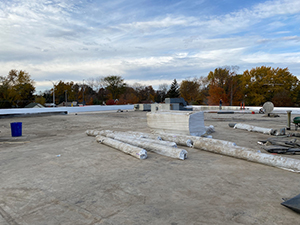
For business owners and property managers in Missoula, Montana, a professionally installed commercial roof is more than a structural necessity; it is a long-term investment in the integrity, efficiency, and safety of their building. However, that investment can easily be compromised by poor installation practices, leading to leaks, insulation failures, or even premature roof replacement. If you are planning a commercial roofing project in Missoula, choosing the right commercial roofing installer is just as critical as choosing the right roofing system. Call Schrock Roofing today at 406-961-2990 to ensure your installation is done right the first time, saving you time, money, and future headaches.
Common Commercial Roof Installer Mistakes
Below, we will break down the most common installation mistakes and explain how seasoned commercial roofing installers avoid them.
Inadequate Surface Preparation
Why It Happens

Rushing into the installation phase without thoroughly cleaning, drying, and priming the roof surface is one of the biggest and most frequent mistakes. It often stems from tight schedules or a lack of training.
The Risk
Debris, moisture, or poorly repaired substrate areas can prevent adhesives or membranes from properly bonding. Over time, this leads to blisters, peeling, or complete membrane failure.
How Pros Avoid It
Professional installers take time to evaluate and prep the entire surface, even if it adds time to the job. This includes removing dirt and oil, repairing underlying damage, and ensuring conditions meet manufacturer standards for temperature and humidity.
Poor Flashing and Sealing
Why It Happens
Flashing is the protective layer that seals roof edges, penetrations, and transitions. It is easy to overlook or rush through these details, especially around HVAC units, drains, or skylights.
The Risk
Improper flashing leads to chronic leaks, the most common cause of roofing failure. Water intrusion at flashing points often spreads unnoticed until major interior damage has occurred.
How Pros Avoid It
Reliable installers treat flashing as a priority, not an afterthought. They use compatible materials, follow manufacturer specs, and custom-fit flashing to each penetration. Inspections during and after installation ensure every vulnerable point is sealed.
Skipping Manufacturer Guidelines
Why It Happens
Every commercial roofing system, TPO, EPDM, PVC, metal, has specific requirements for overlap, fastener spacing, insulation attachment, and curing time. Inexperienced or careless crews may rely on habit rather than documentation.
The Risk
Not following manufacturer guidelines can void warranties and create weak points in the system that fail prematurely.
How Pros Avoid It
Experienced commercial roofing installers are certified by major manufacturers and keep updated on changing specs. They document every step of the process to meet both warranty and quality control standards.
Ignoring Thermal Expansion
Why It Happens
Large commercial roofs are constantly expanding and contracting due to temperature changes, especially in a climate like Missoula’s, which sees wide seasonal shifts. Some contractors underestimate the stress this places on seams and fasteners.
The Risk
Without proper spacing and movement joints, the roof membrane can tear or buckle, leading to water infiltration or system detachment.
How Pros Avoid It
Professional installers plan for expansion from the outset by installing flexible joints, using appropriate adhesives, and spacing materials according to climate conditions.
Inconsistent Insulation Application
Why It Happens
Inadequate or uneven insulation installation is a subtle but costly mistake. It often results from hasty work or a lack of understanding of the insulation’s role in energy efficiency and moisture control.
The Risk
Poor insulation performance increases energy costs and can lead to condensation issues that damage both the roof and interior.
How Pros Avoid It
Trained installers ensure proper insulation attachment, no gaps between boards, and full coverage with compatible vapor barriers. They also evaluate insulation R-values to meet building codes and local climate demands.
World-Class Commercial Roofing Installer
In a location like Missoula, Montana, where snow loads, UV exposure, and freeze-thaw cycles test your roof’s durability year-round, professional installation is non-negotiable. A well-installed commercial roof not only protects your business but can also save thousands on energy, repairs, and downtime.
Whether you’re planning a new building or replacing an aging roof, call Schrock Roofing at 406-961-2990 to work with experienced commercial roofing installers who do the job right from day one.
FAQ
How long should a commercial roof installation take?
It depends on the size and type of roof, but most commercial installations take between 1–3 weeks. Professionals will provide a project timeline up front and communicate any delays.
What are signs of a poorly installed commercial roof?
Common red flags include pooling water, uneven surfaces, visible seams or fasteners, and leaks within the first year. These often indicate deeper structural or installation issues.
Is it worth paying more for an experienced installer?
Absolutely. Poor installation often leads to higher repair costs, shortened roof lifespan, and voided warranties. Experienced installers deliver long-term value and peace of mind.